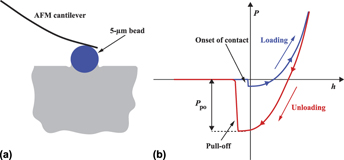Crossref Citations
This article has been cited by the following publications. This list is generated based on data provided by
Crossref.
Wang, Haoran
Wang, Xinnan
Li, Tao
and
Lee, Byeongdu
2013.
Nanomechanical characterization of rod-like superlattice assembled from tobacco mosaic viruses.
Journal of Applied Physics,
Vol. 113,
Issue. 2,
Liu, Bernard Haochih
Li, Kun-Lin
Kang, Kai-Li
Huang, Wen-Ke
and
Liao, Jiunn-Der
2013.
In situbiosensing of the nanomechanical property and electrochemical spectroscopy ofStreptococcus mutans-containing biofilms.
Journal of Physics D: Applied Physics,
Vol. 46,
Issue. 27,
p.
275401.
Borodich, Feodor M.
Galanov, Boris A.
Gorb, Stanislav N.
Prostov, Mikhail Y.
Prostov, Yuriy I.
and
Suarez‐Alvarez, Maria M.
2013.
Evaluation of Adhesive and Elastic Properties of Polymers by the BG Method.
Macromolecular Reaction Engineering,
Vol. 7,
Issue. 10,
p.
555.
Varughese, Sunil
Kiran, M. S. R. N.
Ramamurty, Upadrasta
and
Desiraju, Gautam R.
2013.
Nanoindentation im Kristall‐Engineering: Quantifizierung mechanischer Eigenschaften von Molekülkristallen.
Angewandte Chemie,
Vol. 125,
Issue. 10,
p.
2765.
Cohen, Sidney R
and
Kalfon-Cohen, Estelle
2013.
Dynamic nanoindentation by instrumented nanoindentation and force microscopy: a comparative review.
Beilstein Journal of Nanotechnology,
Vol. 4,
Issue. ,
p.
815.
Varughese, Sunil
Kiran, M. S. R. N.
Ramamurty, Upadrasta
and
Desiraju, Gautam R.
2013.
Nanoindentation in Crystal Engineering: Quantifying Mechanical Properties of Molecular Crystals.
Angewandte Chemie International Edition,
Vol. 52,
Issue. 10,
p.
2701.
Moshtagh, P.R.
Rauker, J.
Sandker, M.J.
Zuiddam, M.R.
Dirne, F.W.A.
Klijnstra, E.
Duque, L.
Steendam, R.
Weinans, H.
and
Zadpoor, A.A.
2014.
Nanomechanical properties of multi-block copolymer microspheres for drug delivery applications.
Journal of the Mechanical Behavior of Biomedical Materials,
Vol. 34,
Issue. ,
p.
313.
Borodich, Feodor M.
2014.
Vol. 47,
Issue. ,
p.
225.
Samuel, R
Thacker, C M
Maricq, A V
and
Gale, B K
2014.
Simple and cost-effective fabrication of microvalve arrays in PDMS using laser cut molds with application toC. elegansmanipulation in microfluidics.
Journal of Micromechanics and Microengineering,
Vol. 24,
Issue. 10,
p.
105007.
Zamil, M. Shafayet
Yi, Hojae
and
Puri, Virendra M.
2015.
The mechanical properties of plant cell walls soft material at the subcellular scale: the implications of water and of the intercellular boundaries.
Journal of Materials Science,
Vol. 50,
Issue. 20,
p.
6608.
Lu, Pin
2015.
A Study of Particles Adhesion to Compliant Substrates with a Modified Sphere Contact Model.
Tribology Letters,
Vol. 58,
Issue. 1,
Díez-Pascual, Ana M.
Gómez-Fatou, Marián A.
Ania, Fernando
and
Flores, Araceli
2015.
Nanoindentation in polymer nanocomposites.
Progress in Materials Science,
Vol. 67,
Issue. ,
p.
1.
Yu, Yalin
Sanchez, Daniel
and
Lu, Nanshu
2015.
Work of adhesion/separation between soft elastomers of different mixing ratios.
Journal of Materials Research,
Vol. 30,
Issue. 18,
p.
2702.
Cheng, M H
Flores De Jesus, K
Cronin, S D
Sierros, K A
and
Bakhoum, E
2015.
A versatile spatial resolution enhancement method for data acquisition.
Measurement Science and Technology,
Vol. 26,
Issue. 4,
p.
045901.
Tsaira, Aikaterini
Karagiannidis, Panagiotis
Sidira, Margarita
Kassavetis, Spyros
Kugiumtzis, Dimitris
Logothetidis, Stergios
Naka, Olga
Pissiotis, Argirios
and
Michalakis, Konstantinos
2016.
Theoretical Considerations and a Mathematical Model for the Analysis of the Biomechanical Response of Human Keratinized Oral Mucosa.
Frontiers in Physiology,
Vol. 7,
Issue. ,
Liu, Yu
Bao, Chao
Nie, Heng-yong
Hui, David
Mei, Jun
and
Lau, Woon-ming
2017.
Carbon-related Materials in Recognition of Nobel Lectures by Prof. Akira Suzuki in ICCE.
p.
421.
Enrique-Jimenez, P.
Quiles-Díaz, S.
Salavagione, H.J.
Wesner, D.
Schönherr, H.
González-Casablanca, J.
García-Quismondo, R.
Martínez, G.
Gómez-Fatou, M.A.
Ania, F.
and
Flores, A.
2017.
Control of the structure and properties of SEBS nanocomposites via chemical modification of graphene with polymer brushes.
European Polymer Journal,
Vol. 97,
Issue. ,
p.
1.
Chlanda, Adrian
Kijeńska, Ewa
Rinoldi, Chiara
Tarnowski, Michał
Wierzchoń, Tadeusz
and
Swieszkowski, Wojciech
2018.
Structure and physico-mechanical properties of low temperature plasma treated electrospun nanofibrous scaffolds examined with atomic force microscopy.
Micron,
Vol. 107,
Issue. ,
p.
79.
Krieg, Michael
Fläschner, Gotthold
Alsteens, David
Gaub, Benjamin M.
Roos, Wouter H.
Wuite, Gijs J. L.
Gaub, Hermann E.
Gerber, Christoph
Dufrêne, Yves F.
and
Müller, Daniel J.
2018.
Atomic force microscopy-based mechanobiology.
Nature Reviews Physics,
Vol. 1,
Issue. 1,
p.
41.
Lu, Shih-Chuan
Du, Wun-Ruei
Huang, Yi-Chen
Tsai, Chun-Pu
and
Li, Wei-Chang
2018.
MEMS Surface Coating Condition Monitoring via Nonlinear Tapping of Resoswitches.
p.
1.





